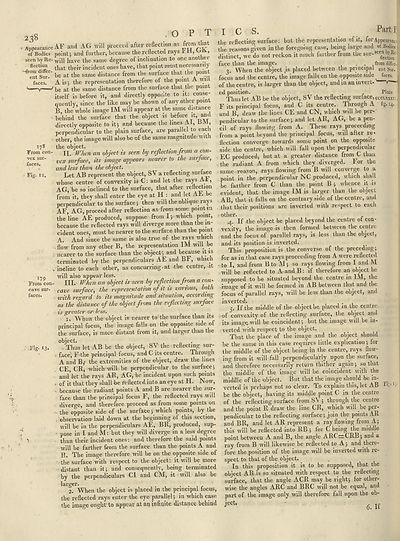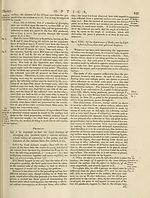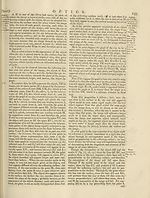Encyclopaedia Britannica > Volume 15, NIC-PAR
(258) Page 238
Download files
Complete book:
Individual page:
Thumbnail gallery: Grid view | List view

238
s Appearance
of Bodies
seen by Re¬
flection
-froni differ¬
ent Sur¬
faces.
17S
From con¬
vex sur¬
faces.
Fig. 12.
179
From con¬
cave sur¬
faces.
Fig- 13*
.OPT
AF and AG will proceed after reflection as from that
point j and further, because the reflected rays I H, Grv,
will have the same degree of inclination to one another
that their incident ones have, that point must necessarily
be at the same distance from the surface that the point
A is; the representation therefore of the point A will
be at the same distance from the surface that the point
itself is before it, and directly opposite to it: conse¬
quently, since the like may be shown of any other point
B, the whole image IM will appear at the same distance
behind the surface that the object is before it, ami
directly opposite to it; and because the lines Al, BM,
perpendicular to the plain surface, are parallel to each
other, the image will also be of the same magnitude with
the object. .
IE. When an object is seen by reflectionJrom a con¬
vex surface, its image appears nearer to the surface,
and less than the object, .
Let AB represent the object, SV a reflecting surface
•whose centre of convexity is C: and let the rays AA,
AG, be so inclined to the surface, that after reflection
from it, they shall enter the eye at H : and let AL be
perpendicular to the surface; then will the oblique rays
AF, AG, proceed after reflection as from some point in
the line AE produced, suppose from ly which point,
because the reflected rays will diverge more than the in¬
cident ones, must be nearer to the surface than the point
A. And since the same is also true of the rays which
flow from any other B, the representation IM will be
: nearer to the surface than the object ; and because it is
terminated by the perpendiculars AE and BF, which
. incline to each other, as concurring at Alie centre, it
will also appear less.
III. When an object is seen by reflection jrom a con¬
cave surface, the representation of it is various, both
with regard to its magnitude and situation, according
as the distance of the object from the reflecting surface
is greater or less.
1, When the object is nearer to the surface than its
principal focus, the image falls on the opposite side of
the surface, is more distant from it, and larger than the
object.
Thus let AB be the object, SV the reflecting sur¬
face; F the principal focus, and C its centre. Through
A and B,< the extremities of the object, draw the lines
CE, CR, which will be perpendicular to the surface;
and let the rays AR, AG, be incident upon such points
of it that they shall be feflected into an eye at H. Now,
because the radiant points A and B are neaiei the sur¬
face than the principal focus F, the reflected rays will
diverge, and therefore proceed as from some points on
the opposite side of the surface; which points, by the
observation laid down at the beginning of this section,
will he in the perpendiculars AE, BR, produced, sup¬
pose in I and M: but they will diverge in a less degree
than their incident ones: and therefore the said points
will he farther from the surface than the points A and
B. The image therefore will be on the opposite side of
the surface with respect to the object: it will be. more
distant than it; and consequently, being terminated
by the perpendiculars Cl and CM, it will also be
larger. . .
2. When the object is placed in the principal focus,
the reflected rays enter the eye parallel; in which case
the image ought to appear at an infinite distance behind
ICS. Parti
the reflecting surface: but the representation of it, for Appearant
the reasons given in the foregoing case, being large and 01 Bodies
distinct, we do not reckon it much farther from the sur-6^.^
face than the image* • • ,from differJ
3. When the object is placed between the principal ent Sur-
focus and the centre, the image falls on the opposite side < faces,
of the centre, is larger than the object, and in an invert- * 1
ed position. , Plate
Thus let AB be the object, SV the reflecting surface, ccci.xxxi
F its principal focus, and C its centre. Through A fig. 14.
and B, draw the lines CE and CN, which will be per¬
pendicular to the surface; and let AR, AG, be a pen¬
cil of rays flowing from A. These rays proceeding
from a point beyond the principal focus, will after re«
flection converge towards some point on the opposite
side the centre, which ivill fall upon the perpendicular
. EC produced, but at a greater distance from C than
the radiant A from Avhich they diverged. lor the
same reason, rays flowing from B will converge to a
point in the perpendicular NC produced, which shall
be farther from C than the point B ; whence it is
evident, that the image IM is larger than the object
AB, that it falls on the contrary side of the centre, and
that their positions are inverted with respect to each
other.
,4. If the object be placed beyond the centre of con¬
vexity, the image is then formed between the centre
and the focus of parallel rays, is less than the object,
and its position is inverted.
This proposition is the converse of the preceding;
for as in that case rays proceeding from A wrere reflected
to I, and from B to M; so rays flowing from I and M
will be reflected to A-and B: if therefore an object be
supposed to be situated beyond the centie in IM, thi-
image of it will be formed in AB between that and the
focus of parallel rays, will be less than the object, and
inverted. _
5. If the middle of the object he placed in the centie
of convexity of the reflecting surface, the object and
its image, will be coincident; but the image will be in¬
verted with respect to the object.
That the place of the image and the object should
be the same in this case requires little explication; foi
the middle of the object being in the centre, rays flow¬
ing from it will fall perpendicularly upon the suiface,
and therefore necessarily return thither again; so that
the middle of the image will be coincident with the
middle of the object. But that the image should be in-
verted is perhaps not so clear. To explain this, let AB Fl£. lr
be the object, having its middle point C in the centre
of the reflecting surface from SV; through the centre
and the point R draw the line CR, which will be per¬
pendicular to the reflecting surface; join the points AR
and BR, and let AR represent a ray flowing from A;
this will be reflected into RB ; for C being the middle
point between A and B, the angle ARCnzCRB; and a
ray from B will likewise be reflected to A; and there¬
fore the position of the image will be inverted with re¬
spect to that of the object.
In this proposition it is to be supposed, that the
object AB is so situated with respect to the reflecting
surface, that the angle ACR may be right; for other¬
wise the angles ARC and BRC will not be equal, and
part of the image only will therefore fall upon the ob-
iectl ’ 6. If
s Appearance
of Bodies
seen by Re¬
flection
-froni differ¬
ent Sur¬
faces.
17S
From con¬
vex sur¬
faces.
Fig. 12.
179
From con¬
cave sur¬
faces.
Fig- 13*
.OPT
AF and AG will proceed after reflection as from that
point j and further, because the reflected rays I H, Grv,
will have the same degree of inclination to one another
that their incident ones have, that point must necessarily
be at the same distance from the surface that the point
A is; the representation therefore of the point A will
be at the same distance from the surface that the point
itself is before it, and directly opposite to it: conse¬
quently, since the like may be shown of any other point
B, the whole image IM will appear at the same distance
behind the surface that the object is before it, ami
directly opposite to it; and because the lines Al, BM,
perpendicular to the plain surface, are parallel to each
other, the image will also be of the same magnitude with
the object. .
IE. When an object is seen by reflectionJrom a con¬
vex surface, its image appears nearer to the surface,
and less than the object, .
Let AB represent the object, SV a reflecting surface
•whose centre of convexity is C: and let the rays AA,
AG, be so inclined to the surface, that after reflection
from it, they shall enter the eye at H : and let AL be
perpendicular to the surface; then will the oblique rays
AF, AG, proceed after reflection as from some point in
the line AE produced, suppose from ly which point,
because the reflected rays will diverge more than the in¬
cident ones, must be nearer to the surface than the point
A. And since the same is also true of the rays which
flow from any other B, the representation IM will be
: nearer to the surface than the object ; and because it is
terminated by the perpendiculars AE and BF, which
. incline to each other, as concurring at Alie centre, it
will also appear less.
III. When an object is seen by reflection jrom a con¬
cave surface, the representation of it is various, both
with regard to its magnitude and situation, according
as the distance of the object from the reflecting surface
is greater or less.
1, When the object is nearer to the surface than its
principal focus, the image falls on the opposite side of
the surface, is more distant from it, and larger than the
object.
Thus let AB be the object, SV the reflecting sur¬
face; F the principal focus, and C its centre. Through
A and B,< the extremities of the object, draw the lines
CE, CR, which will be perpendicular to the surface;
and let the rays AR, AG, be incident upon such points
of it that they shall be feflected into an eye at H. Now,
because the radiant points A and B are neaiei the sur¬
face than the principal focus F, the reflected rays will
diverge, and therefore proceed as from some points on
the opposite side of the surface; which points, by the
observation laid down at the beginning of this section,
will he in the perpendiculars AE, BR, produced, sup¬
pose in I and M: but they will diverge in a less degree
than their incident ones: and therefore the said points
will he farther from the surface than the points A and
B. The image therefore will be on the opposite side of
the surface with respect to the object: it will be. more
distant than it; and consequently, being terminated
by the perpendiculars Cl and CM, it will also be
larger. . .
2. When the object is placed in the principal focus,
the reflected rays enter the eye parallel; in which case
the image ought to appear at an infinite distance behind
ICS. Parti
the reflecting surface: but the representation of it, for Appearant
the reasons given in the foregoing case, being large and 01 Bodies
distinct, we do not reckon it much farther from the sur-6^.^
face than the image* • • ,from differJ
3. When the object is placed between the principal ent Sur-
focus and the centre, the image falls on the opposite side < faces,
of the centre, is larger than the object, and in an invert- * 1
ed position. , Plate
Thus let AB be the object, SV the reflecting surface, ccci.xxxi
F its principal focus, and C its centre. Through A fig. 14.
and B, draw the lines CE and CN, which will be per¬
pendicular to the surface; and let AR, AG, be a pen¬
cil of rays flowing from A. These rays proceeding
from a point beyond the principal focus, will after re«
flection converge towards some point on the opposite
side the centre, which ivill fall upon the perpendicular
. EC produced, but at a greater distance from C than
the radiant A from Avhich they diverged. lor the
same reason, rays flowing from B will converge to a
point in the perpendicular NC produced, which shall
be farther from C than the point B ; whence it is
evident, that the image IM is larger than the object
AB, that it falls on the contrary side of the centre, and
that their positions are inverted with respect to each
other.
,4. If the object be placed beyond the centre of con¬
vexity, the image is then formed between the centre
and the focus of parallel rays, is less than the object,
and its position is inverted.
This proposition is the converse of the preceding;
for as in that case rays proceeding from A wrere reflected
to I, and from B to M; so rays flowing from I and M
will be reflected to A-and B: if therefore an object be
supposed to be situated beyond the centie in IM, thi-
image of it will be formed in AB between that and the
focus of parallel rays, will be less than the object, and
inverted. _
5. If the middle of the object he placed in the centie
of convexity of the reflecting surface, the object and
its image, will be coincident; but the image will be in¬
verted with respect to the object.
That the place of the image and the object should
be the same in this case requires little explication; foi
the middle of the object being in the centre, rays flow¬
ing from it will fall perpendicularly upon the suiface,
and therefore necessarily return thither again; so that
the middle of the image will be coincident with the
middle of the object. But that the image should be in-
verted is perhaps not so clear. To explain this, let AB Fl£. lr
be the object, having its middle point C in the centre
of the reflecting surface from SV; through the centre
and the point R draw the line CR, which will be per¬
pendicular to the reflecting surface; join the points AR
and BR, and let AR represent a ray flowing from A;
this will be reflected into RB ; for C being the middle
point between A and B, the angle ARCnzCRB; and a
ray from B will likewise be reflected to A; and there¬
fore the position of the image will be inverted with re¬
spect to that of the object.
In this proposition it is to be supposed, that the
object AB is so situated with respect to the reflecting
surface, that the angle ACR may be right; for other¬
wise the angles ARC and BRC will not be equal, and
part of the image only will therefore fall upon the ob-
iectl ’ 6. If
Set display mode to:
![]() Universal Viewer |
Universal Viewer | ![]() Mirador |
Large image | Transcription
Mirador |
Large image | Transcription
Images and transcriptions on this page, including medium image downloads, may be used under the Creative Commons Attribution 4.0 International Licence unless otherwise stated. ![]()
| Encyclopaedia Britannica > Encyclopaedia Britannica > Volume 15, NIC-PAR > (258) Page 238 |
|---|
| Permanent URL | https://digital.nls.uk/192585052 |
|---|
| Attribution and copyright: |
|
|---|
| Shelfmark | EB.11 |
|---|---|
| Description | Ten editions of 'Encyclopaedia Britannica', issued from 1768-1903, in 231 volumes. Originally issued in 100 weekly parts (3 volumes) between 1768 and 1771 by publishers: Colin Macfarquhar and Andrew Bell (Edinburgh); editor: William Smellie: engraver: Andrew Bell. Expanded editions in the 19th century featured more volumes and contributions from leading experts in their fields. Managed and published in Edinburgh up to the 9th edition (25 volumes, from 1875-1889); the 10th edition (1902-1903) re-issued the 9th edition, with 11 supplementary volumes. |
|---|---|
| Additional NLS resources: |
|

